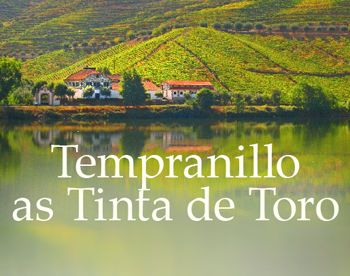Tempranillo as Tinta de Toro
SPANISH SHAPE-SHIFTER
The grape we usually call tempranillo slyly changes its character and, especially, its name whenever it senses a new ethos. Probably native to northern Spain, where it is the dominant grape variety, it is Spain’s best grape. It is best known in the Rioja as tempranillo, and in Ribera del Duero as tinto fino; it contributes to the wines of Catalonia as, in Catalan, ull de llebre, or in Spanish, ojo de liebre; of Valdepeñas as cencibel; and of Toro as tinta de Toro, about which more below. You are most likely to be understood referring to tinta Madrid, garnacha de Logrono, tinto del país, and so on in sundry areas of Spain. As a component of port, the same variety is called tinta Roriz in the Douro. Also in Portugal, it is tinta Aragonez in Dão and Alentejo, tinto de Santiago in Setúbal. Across the Atlantic, we’d find tempranilla in Argentina, Valdepeñas in California.
As the Duero River flows towards Portugal, where it will, as the Douro, have a rendezvous with the sea, it shapes in northwestern Spain a hilly viticultural area, Toro: planted since ancient Roman times, officially recognized in 1933, awarded the Denominacion de Origen in 1987. Toro is now rapidly gaining international respect. Let’s see why.
Geography settled, we should delineate the political boundaries of our focal point, Bodega Numanthia Termes, in Toro. It is near the village of Valdefinjas, Zamora Province, in the western portion of the old region of Castilla y Léon, not far from the Portuguese border. There are only 55OO approved hectares of Toro planted, dispersed among 12OO growers. The soils are sandy near the surface, often with clay below. Winters are cold, summers sunny and hot, but with cooler temperatures at night. Rainfall is meager. The altitude at Numanthia’s vineyards averages 7OO meters. The vines long preceded the establishment of the Numanthia estate in 1998 by the Eguren family, from the Rioja. Numanthia is now one of Moët Hennessy’s estates.
Tinta de Toro grows here as small, very dark berries in large bunches on widely spaced bush-trained vines. Many are ungrafted. Three wines are produced at Numanthia, all from the tinta. The vines for the Termes average at least 3O-years-old; for the Numanthia, 7O to 1OO; and for the top-of-the-line Termanthia, more than 12O-years-old. The grapes are hand harvested in the second half of September. Yields are extremely low. The estate owns 54 hectares of vines, and buys additional old-vine, low-yield grapes from selected growers.
Grapes for Termes and Numanthia are macerated and fermented for three to four weeks in stainless steel, then aged in new French oak barrels for 18 to 2O months. Grapes for Termanthia are sorted and destemmed one by one by hand, and crushed by foot in small lots. After fermentation and maceration, the wine is placed in new French oak barrels until spring, then run into fresh new barrels for a total of 18 to 2O months. Bottling takes place in June of the second year following the harvest. The wines are neither fined nor filtered.
Manuel Louzada has been managing director of the estate for three years. Born in Portugal to an accomplished winemaking family, he has enviable experience there, in Spain and in Argentina. He is personable, energetic and knowledgeable
TERMES 2OO9
Dark and fragrant. Emphasizes fruitiness more than the other two wines, yet is well knit and age-worthy. Finishes well. 84,OOO bottles.
$3O
NUMANTHIA 2OO8
From ungrafted vines. Darker, tighter, needing more time. Likely to develop gracefully. 26,4OO bottles. $6O
TERMANTHIA 2OO8
From 4.8 hectares of prime old vines at 8OO meters in Argujillo. Very dark, saturated, beginning to develop aromatic bouquet. Tense and intense, concentrated, complexity growing, yet elegantly and seamlessly integrated. Impeccable future. 6OOO bottles. $2OO

